Evaluation of trauma patients admitted to the emergency department of in Mogadishu Training and Research Hospital, Somalia: Cross-sectional study of 1106 patients
Keywords:
Emergency medicine, Trauma patients, SomaliaAbstract
Aim: Trauma-related injuries are among the most pressing issues today, causing economic, social, and healthcare burdens. The aim of this study is to better manage and approach trauma patients by comparing our results with the literature, and reach standards set by developed countries.
Methods: Data of patients who were admitted to the emergency service of Mogadishu Somalia Turkish Training and Research Hospital with trauma between 1 September 2017 and 30 April 2018 were retrospectively obtained from the hospital registry and patient files. Demographic data such as the age, gender, means of injury, site of injury, department of hospitalization and discharge/death records were recorded and analyzed. Descriptive statistics and chi-square test were used. P<0.05 was considered statistically significant.
Results: Among 11225 patients admitted to the emergency department, 1106 were trauma patients. 29.3% were females and 70.7% were males. 49.9% of the patients (n=551) were discharged from the emergency service after follow-up, and 50.1% (n=541) were admitted to various departments. 14 patients died in the emergency service.
Conclusion: Traumas constitute about a quarter of referrals to the emergency service in developed countries. In Somalia, this ratio was about 1:10. Proper management during the pre-hospitalization and hospitalization periods and transferal of patients when needed may help reduce the morbidity and mortality of trauma patients.
Downloads
References
Ertekin C. Multipl Travmalı Hastaya Yaklaşım. Yoğun Bakım Dergisi. 2002;2(2):77-87.
Battistella F, Benfield JR. Blunt and penetrating injuries of the chest wall, pleura and lungs. General thoracic surgery 5th ed Philadelphia: Lippincott Williams & Wilkins. 2000:815-31.
Miniño AM, Heron MP, Smith BL. Deaths: preliminary data for 2004. National vital statistics reports. 2006;54(19):1-49.
Burt CW, Fingerhut LA. Injury visits to hospital emergency departments: United States, 1992-95: Department of Health and Hu Ol and Prevention Nati; 1998.
Mackenzie E, Fowler C. Epidemiology of injury. Trauma 5th ed New York, NY: McGraw-Hill Companies, Inc. 2003.
Mattox KL, Maningas PA, Moore EE, Mateer JR, Marx JA, Aprahamian C, et al. Prehospital hypertonic saline/dextran infusion for post-traumatic hypotension. The USA Multicenter Trial. Annals of surgery. 1991;213(5):482.
Edition TS. Mc Graw Hill Medical. Feliciano, D, Mattox K, Moore E. 2008.
Greenspan L, McLELLAN BA, Greig H. Abbreviated Injury Scale and Injury Severity Score: a scoring chart. The Journal of trauma. 1985;25(1):60-4.
Rating the severity of tissue damage. I. The abbreviated scale. Jama. 1971;215(2):277-80. Epub 1971/01/11. doi: 10.1001/jama.1971.03180150059012.
Becher RD, Meredith JW, Kilgo PD. Injury severity scoring and outcomes research. Mattox KL, Moore EE, Feliciano DV, editors Trauma 7th ed New York: McGraw-Hill. 2013.
Nourjah P. National hospital ambulatory medical care survey: 1997 emergency department summary. Advance data from vital and health statistics. 1997(304).
Akoğlu H, Denizbaşı A, Ünlüer E, Güneysel Ö, Onur Ö. Marmara Üniverstesi Hastanesi acil servisine başvuran travma hastalarının demografik özellikleri. Marmara Medical Journal. 2005;18(3):113-22.
Burt CW. Injury-related visits to hospital emergency departments: United States, 1992. 1995.
Eachempati SR, Reed RL, Louis JES, Fischer RP. "The Demographics of Trauma in 1995" Revisited: An Assessment of the Accuracy and Utility of Trauma Predictions. Journal of Trauma and Acute Care Surgery. 1998;45(2):208-14.
Durdu T. Analysis of trauma cases admitted to the emergency department. Journal of Clinical and Analytical Medicine. 2013;5(93):182-5.
Varol O, Eren ŞH, Oğuztürk H, Korkmaz İ, Beydilli İ. Acil servise trafik kazası sonucu başvuran hastaların incelenmesi. CÜ Tıp Fakültesi Dergisi. 2006;28(2):55-60.
Linn S. The injury severity score—importance and uses. Annals of epidemiology. 1995;5(6):440-6.
Rating the severity of tissue damage. I. The abbreviated scale. JAMA. 1971 Jan 11;215(2):277-80.
Boyd CR, Tolson MA, Copes WS. Evaluating trauma care: the TRISS method. Trauma Score and the Injury Severity Score. The Journal of trauma. 1987;27(4):370-8.
Champion HR, Copes WS, Sacco WJ, Frey CF, Holcroft JW, Hoyt DB, et al. Improved predictions from a severity characterization of trauma (ASCOT) over Trauma and Injury Severity Score (TRISS): results of an independent evaluation. Journal of Trauma and Acute Care Surgery. 1996;40(1):42-9.
Downloads
- 1066 1712
Published
Issue
Section
How to Cite
License
Copyright (c) 2019 Mustafa Enes Demirel, İbrahim Hussein Ali
This work is licensed under a Creative Commons Attribution-NonCommercial-NoDerivatives 4.0 International License.
















